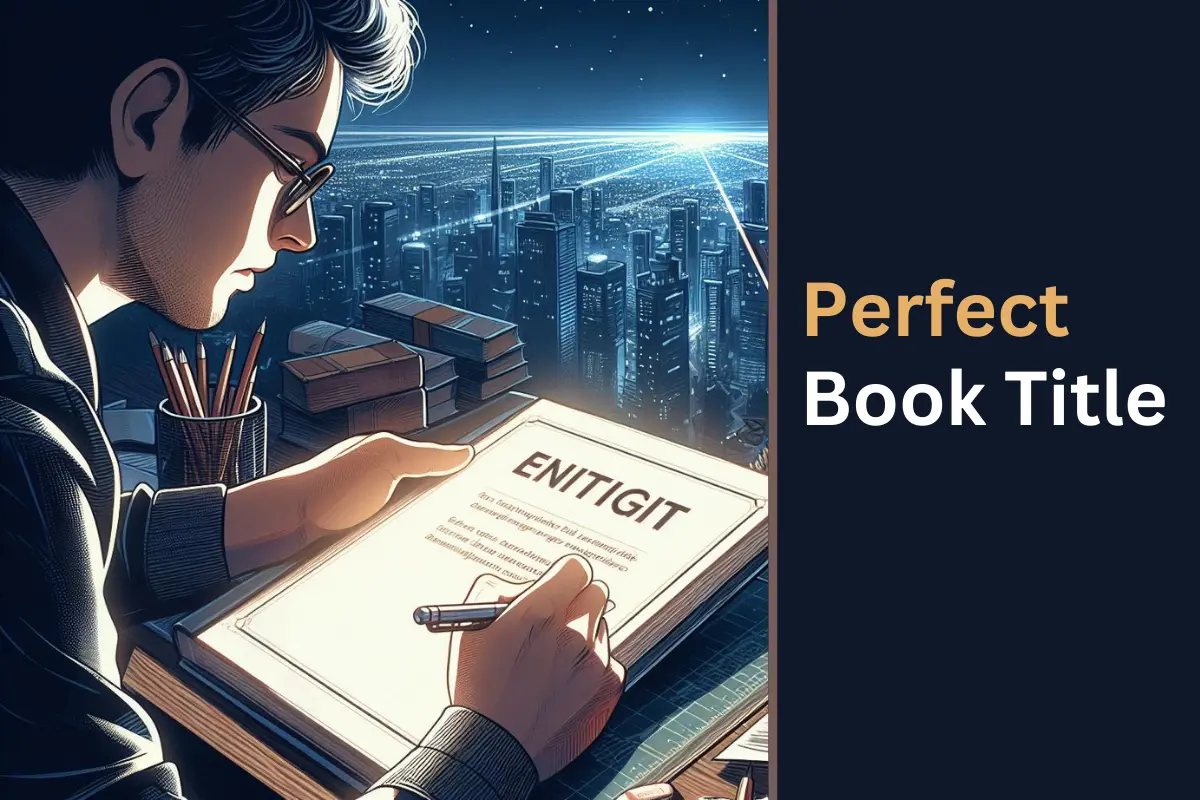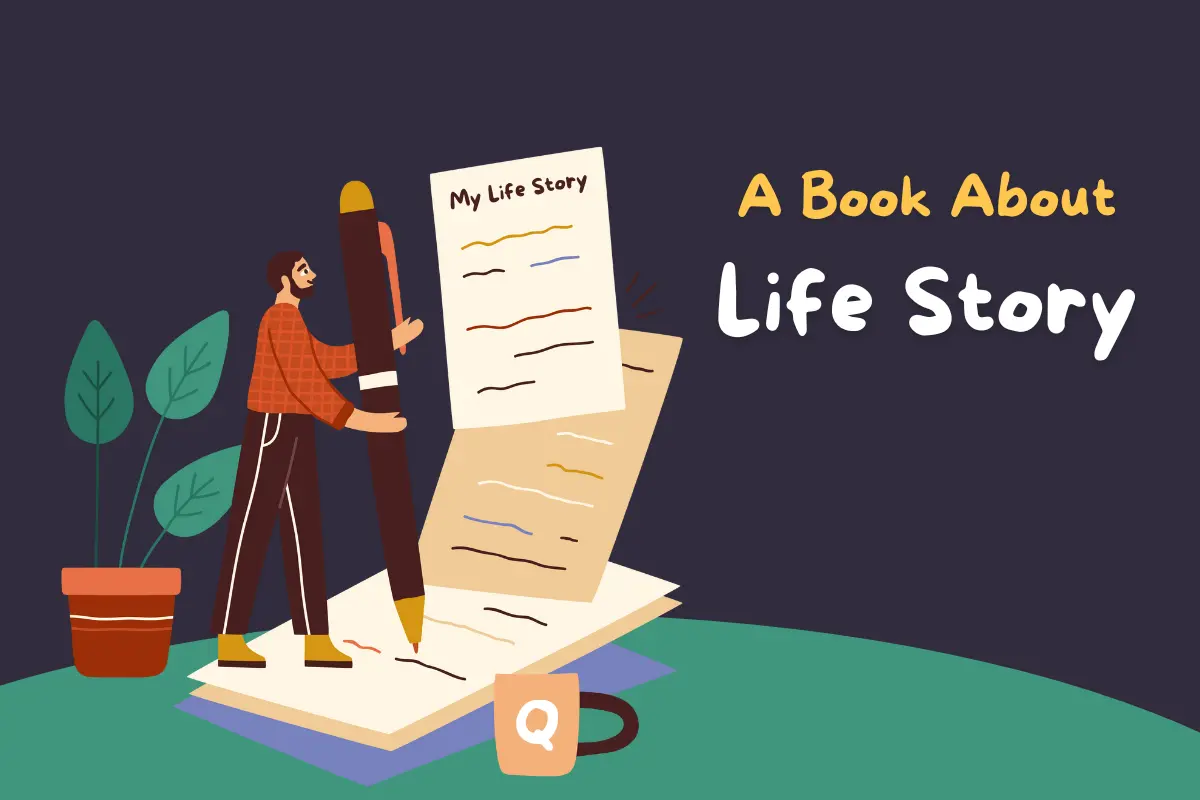How to Write a Book Title in 8 Steps With Examples
Master the art of captivating book titles today! Dive in now and make your story shine.

Rijvi Ahmed
Last updated on Mar 14th, 2024

When you click on affiliate links on QuillMuse.com and make a purchase, you won’t pay a penny more, but we’ll get a small commission—this helps us keep up with publishing valuable content on QuillMuse. Read More.
Table of Contents
You have penned a book, then. Best wishes! Do you mean the difficult part is over? Kind of. Before you publish your book, you still need to do some more brainstorming. The next step is to learn how to develop a book title that draws potential readers in and encourages them to pick up your book.
Or perhaps you’ve just decided to write a book and are looking for ideas from book titles. Having a working title in place before starting your first rough draft is usually a smart idea.
Get our best-loved free tool for coming up with hundreds of amazing book names quickly by reading on to find out how to develop a book title that grabs everyone’s attention!
What is a book title?
A book title is like the front door to a whole new world. It’s the catchy name that graces the cover, beckoning readers to come and explore the wonders within its pages. Just like a movie title sets the stage for what’s to come, a book title hints at the story’s essence or theme, enticing readers to dive into the adventure, mystery, or knowledge waiting inside. So, whether it’s a whimsical fairy tale or a gripping thriller, a book’s title is its first chance to make a lasting impression on readers everywhere.
Why is book title important?
According to Wikipedia[1], the title of a book, or any other published text or work of art, is a name for the work that is usually chosen by the author. A carefully chosen book title plays a crucial role in attracting readers, generating interest, and setting the stage for an engaging reading experience.
Here are some noticeable benefits:
- First Impression: The book title is the first thing potential readers encounter. It serves as the initial point of contact, capturing attention and inviting further exploration.
- Reflects Content: A well-crafted title offers a glimpse into the content of the book. It conveys the themes, tone, and essence of the narrative, giving readers an idea of what to expect.
- Sets Expectations: The title sets expectations for the reader. It helps them understand the genre, mood, and style of the book, guiding their decision to pick it up and read.
- Memorability: A memorable title sticks in the minds of readers. It becomes a reference point, making it easier for readers to recall and recommend the book to others.
- Marketing Tool: The title serves as a marketing tool for the book. It can attract attention in crowded bookstores or on online platforms, enticing potential readers to explore further.
- Differentiation: In a sea of books, a unique title helps the book stand out. It distinguishes the book from others in the same genre and captures the attention of readers browsing for their next read.
- Reader Engagement: Ultimately, the title is crucial to reader engagement. It’s the gateway to the book’s world, enticing readers to dive in and experience the story firsthand.
5 qualities of a good book title
You’ve written your book after putting in a lot of work and studying how to write books. Now, you want to become a bestselling author by publishing your great book. Every great book deserves a title that does it justice—a title that pops, resonates, and most importantly, sells. But, what defines one title from another? Here’s a deep dive into the core principles of a winning book title.
1. Attention-grabbing
We’ve all heard the old quote: never judge a book by its cover. But in reality? We do this. That’s why, in a world of endless choices, your title needs to grab attention.
However, attention-grabbing doesn’t mean being fake. It’s about hitting a chord with genuine curiosity, not just being loud. It creates intrigue, prompting the reader to want to know more about the book’s contents.
Additionally, in an increasingly competitive market, a compelling title can help a book stand out among the crowd, attracting attention and enticing potential readers to delve into the story.
2. Memorable and searchable
It’s much easier to get a reaction out of someone and then be forgotten than it is to get a reaction and also be memorable.
Remember that a book’s title is not just the first thing a reader hears about your book; it is also the sole piece of information a potential reader has that directs them back to the book itself.
This also implies that you want the book title to be easily searchable. In today’s environment, people use search to find stuff. If your title is difficult to remember and search on Google and Amazon, it is really terrible.
In today’s digital age, where a Google or Amazon search may make or break a purchase, a title needs to be memorable and searchable. If a buddy recommends your book to them but they can’t recall the title, they won’t be able to find it in a bookstore or online.
3. Clear and informative
In an information-rich world, a clear title can serve as a lighthouse for potential readers. It should hint at what to expect without giving too much away.
Consider The 7 Habits of Highly Effective People, for instance. The title is simple, implying positive practices while enticing readers to learn more about these seven habits.
So, while creating your title, aim for the sweet spot between informative and mysterious. Make sure it gives readers a taste of the book’s main topic and encourages them to read more.
4. Easy & not embarrassing to say
Cognitive fluency refers to the concept of having an easy-to-pronounce title. It means that people are more likely to recall and respond to words and phrases that are easy to comprehend and pronounce.
People dislike feeling uneasy in social situations. If a book title is difficult to say, or, more crucially, if it is a phrase that sounds foolish when spoken aloud, they are far less likely to purchase it, and they are unlikely to discuss it with others.
One of the most crucial factors to consider when choosing a book title is word of mouth. Consider how people will react to saying this book title aloud to their friends. Does it make them look smarter or stupid?
5. Short
A book title should be short because it’s easier for people to remember. When a title is concise, it sticks in our minds more easily, making it simpler to recall later on. Plus, short titles are easier to say out loud, so they’re more likely to be shared in conversations or recommended to friends.
Visually, short titles pack a punch, especially on book covers or in advertisements where space is limited. They catch the eye and draw readers in quickly. In today’s fast-paced world, where our attention spans are short, short titles are more likely to grab our attention and hold it.
When we’re searching online or typing into a search engine, shorter titles are quicker and easier to type, making it more likely that we’ll find the book we’re looking for. So, a short book title isn’t just about being brief—it’s about making a big impact.

How to write a book title in 8 steps
Crafting a winning book title is much like preparing a gourmet dish: it requires the right ingredients, preparation, and presentation. If you are self-publishing then you are the author, book editor, and cover designer, you will do your book review and you have to choose your title. By following this rigorous strategy, you will set your book up for success from the start.
1. Be clear on your book’s purpose
Choosing the perfect title for your book is more than just a creative endeavor—it’s a strategic decision that can significantly impact its success. Before settling on a title, it’s crucial to be clear on your book’s purpose and how you want it to resonate with your audience.
Every book serves a specific purpose, whether it’s to entertain, educate, inspire, or provoke thought. Understanding your book’s purpose is the cornerstone of crafting a title that effectively communicates its message and resonates with your target readership. For instance, if your book aims to provide practical tips for personal development, your title should reflect this purpose by being clear, concise, and engaging.
Moreover, a well-chosen title can contribute to the overall branding and positioning of your book. By conveying the essence of your book succinctly and memorably, your title can help establish your author brand and differentiate your book from others in the same genre or category.
Being clear on your book’s purpose is essential when choosing a title. By aligning your title with your book’s intended message, audience, and market positioning, you can enhance its discoverability, marketability, and overall effectiveness.
So, take the time to carefully consider your book’s purpose and craft a title that reflects its essence and resonates with your target audience.
2. Understand the structure of the book title
Nonfiction book titles have a common structure: a title of 5 words or fewer and a subtitle of 3 to 7 syllables. These are only guidelines; book titles and subtitles may be longer or shorter.
- Title: 5 words more or less
- Subtitle: 3 to 7 words
The length of the title and subtitle varies because they serve distinct purposes. While the title’s purpose is to capture the reader’s attention while signaling what the book is about, the subtitle has to provide more information about what the book promises to offer.
- Title: hook
- Subtitle: explanation
Here are some examples you can see:
- 12 Rules for Life: An Antidote for ChaosMindfulness in Plain English
- Dare to Lead
- Can’t Hurt Me
- Girl, Wash Your Face
- The 7 Habits of Highly Effective People
- Atomic Habits: An Easy & Proven Way to Build Good Habits and Break Bad Ones
- How to Win Friends and Influence People
3. Define the right tone and style for the title
When it comes to crafting a compelling title, striking the right tone and style is essential. Your title serves as the first impression of your content, setting the tone for what readers can expect and enticing them to delve deeper.
Here are some tone examples:
- Confident
- Joyful
- Friendly
- Negative
- Urgent
- Elegant
- Strong
Some audiences appreciate a casual style, while others prefer a more formal one. Here are the three possible styles:
- Informal
- Formal
- Neutral
You may draw your audience by being deliberate about your tone and style. For example, you should adopt a negative tone to appeal to an unhappy audience, and an upbeat tone to appeal to a hopeful one.
4. Select strong, visual words that invite readers
Now that you’ve established the framework for your title, it’s time to select the actual words you’ll use. In this sense, it is critical to recall the many words available to us, generally known as parts of speech.
While you have various options for parts of speech, not all of them are made equal. In other words, some are more significant than others, and while you may utilize some, you are unlikely to use them all.
Nouns and verbs are the most significant portions of speech because they are the primary content words—the ones that generate images. Verbs describe activities, whereas nouns describe people, objects, or concepts. Both can serve as the basis for your book title.
Building a Business in 7 Easy Steps, for example, employs a verb and refers to a highly useful book. Business Creation 101, which employs a term, does not seem as practical, though it may be. Meanwhile, The Making of an Enduring Business, which employs a separate verb and adjective, seems more beautiful than the previous two names.
5. Research to ensure the originality of the title
This is one technique to create a unique title: do not copy an existing one. Even if it was inadvertent, it might make you appear lazy if readers believe you simply copied it. Spend some time investigating to ensure that the book title is not already being used.
It is not uncommon for book names to be copied. Sometimes the same title is appropriate for many novels. If two books with the same title are distributed in different regions of the world, this is acceptable.
If you believe, or simply hope, that your book will be popular globally, select something fresh and unique.
6. Consider the characters
Some authors title their books after the name of the main character. If your story is heavily character-driven, and the primary character is the focal point, consider using their name as the title.
While it will not reveal the storyline, it will inform readers that this person is the true focus of the story.
It will emphasize the importance of this character. If you title your book after a character, readers will know them as soon as they appear in the story.
This can be used strategically when introducing a character. If their name is in the title, you will not need to do or say anything to alert readers to the importance of this character.
7. Create several title choices
Create a few possible titles and rank them in the order that you believe is most appropriate. Having a few options allows you to decide the best solution for your book. The order in which you placed them may alter as the story progresses.
First and foremost, why is it essential to create several title choices? Having multiple title options allows you to explore different themes, angles, and styles that may resonate with your target audience.
It also provides flexibility and ensures you have alternatives if your preferred title is already in use or doesn’t perform well in market testing. Additionally, generating multiple title choices encourages creativity and allows you to consider various perspectives, ultimately leading to a more refined and impactful title.
Consider the emotions or reactions you want to evoke in readers and explore different words, phrases, and metaphors that encapsulate these sentiments. Don’t be afraid to think outside the box and experiment with unconventional or unexpected title options.
8. Choose your book title and make a final decision
Target market input is subjective, and everyone will have different perspectives. While you should not let it determine everything, you must take this input carefully. As a general guideline, pay attention to any point raised by more than three persons.
You should not modify your title only to appease your target readers; nevertheless, in many circumstances, your readers will point you in the proper route. For example, if three or more readers report that the title is confusing, it’s reasonable to assume that your title needs some improvement.
It’s generally a good idea to have a couple of backup titles in case your initial title doesn’t connect with your target audience. You may also make changes to your title, such as changing the sentiment, image, and explanation in the subtitle.
After making changes to your title, run it by your target audience one more time to see what they think. If you are still looking for a title that works, is interesting, and resonates with your target audience, you may need to repeat the process numerous times. Your book title is important, after all.
On the best writing websites, you will find some book title generators. You can use them if you want. These tools are free; you can try them and see the results.
FAQs on How to Write a Book Title
Why is choosing the right book title important?
The book title is often the first thing potential readers notice. It can spark interest, convey the essence of the book, and influence purchasing decisions. A compelling title can make a significant difference in the success of a book.
How can I come up with a catchy book title?
Start by brainstorming keywords and themes related to your book’s content. Experiment with different combinations, consider symbolism or metaphors, and aim for a title that piques curiosity while accurately representing your book.
Should the book title directly reflect the content of the book?
Ideally, yes. While some authors opt for abstract or metaphorical titles, it’s generally beneficial for the title to provide insight into the book’s subject matter or themes. This helps potential readers understand what to expect.
Are there any common pitfalls to avoid when choosing a book title?
Avoid overly generic titles that don’t stand out or provide any indication of what the book is about. Additionally, be mindful of unintentional associations or connotations that could confuse or mislead readers.
Is it okay to change the book title after the book has been published?
It’s uncommon but not unheard of for authors to change a book title post-publication, especially if the original title isn’t resonating with readers or accurately representing the content. However, it can be logistically challenging and may require updates to marketing materials and ISBN listings.
How long should a book title be?
There’s no strict rule, but shorter titles tend to be more memorable and impactful. Aim for a title that is succinct yet descriptive, typically ranging from a few words to a short phrase.
Should I research to see if my title is unique?
Yes, it’s advisable to search for existing books with similar titles to avoid confusion or potential legal issues. Conducting thorough research can also help ensure that your title stands out in the market.
Are there any specific formatting guidelines for book titles?
While there are no strict formatting rules, titles are typically capitalized and centered on the cover and title page. It’s also common to use bold or larger font sizes to make the title more prominent.
Can I seek feedback on potential book titles before making a final decision?
Absolutely! Soliciting feedback from beta readers, writing groups, or trusted friends and colleagues can provide valuable insights and help you gauge the effectiveness of different title options.
How we've reviewed this article
Our content is thoroughly researched and fact-checked using reputable sources. While we aim for precision, we encourage independent verification for complete confidence.
We keep our articles up-to-date regularly to ensure accuracy and relevance as new information becomes available.
- Current Version
- Mar 14th, 2024
- Mar 1st, 2024



